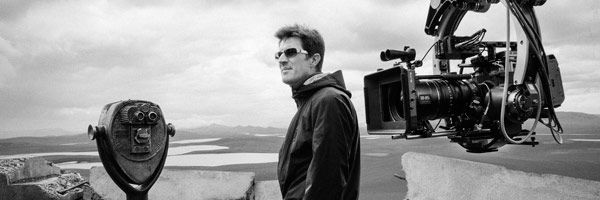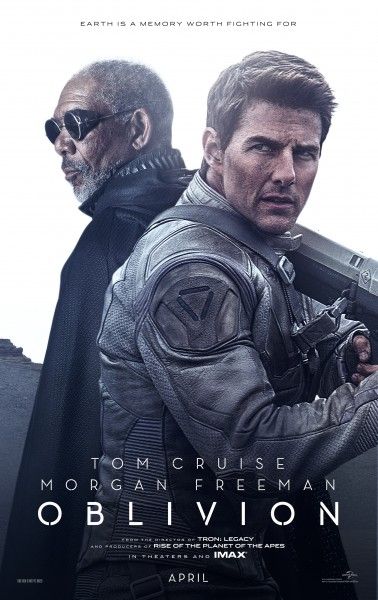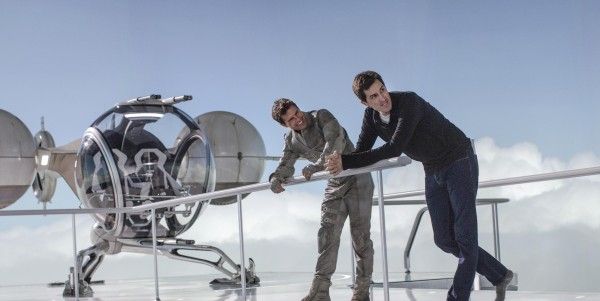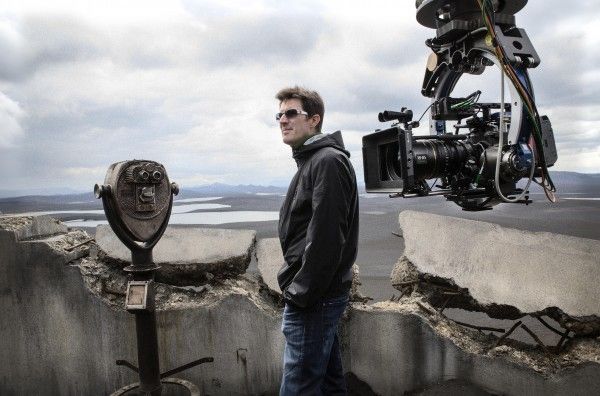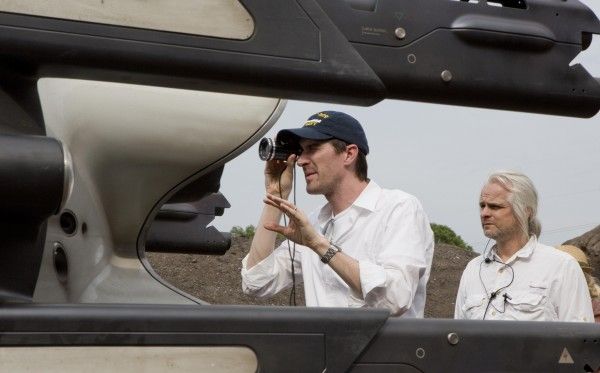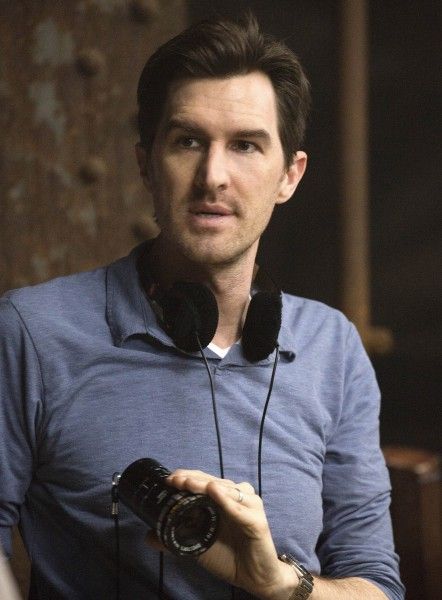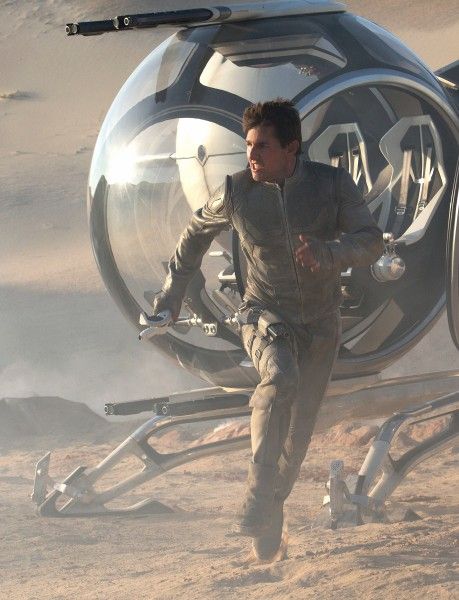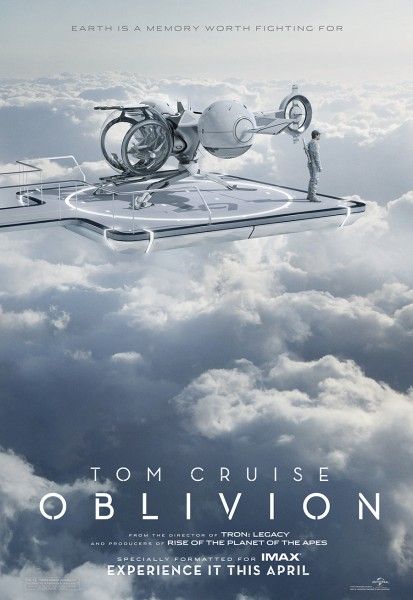Producer/director Joseph Kosinski’s visionary sci-fi epic, Oblivion, was inspired by his graphic novel written in 2005 which became the pitch for the film. Set in the year 2077, the story centers on Jack Harper (Tom Cruise), a security repairman stationed on an evacuated, post-apocalyptic Earth who is part of a massive operation to extract vital resources after decades of war with a terrifying alien threat. When Jack rescues a beautiful stranger (Olga Kurylenko) from a downed space craft, her arrival triggers a chain of events that forces him to question everything he thought he knew. Opening this Friday, the film also stars Morgan Freeman, Andrea Riseborough and Melissa Leo.
At the recent press day at Universal Studios, Kosinski discussed how the finished film compared to what he had originally envisioned, why he likes movies that ask big questions but don’t necessarily answer all of them, the challenges of creating a sci-fi world that’s never been seen before, getting M83’s Anthony Gonzalez to compose the cool score, what the actors brought to their roles, how his background in mechanical engineering and industrial design influenced the film’s groundbreaking visual design, collaborating with DP Claudio Miranda on the high definition front projection, and why he chose not to do 3D. Hit the jump for the interview.
How did the finished film compare to what you originally envisioned?
JOSEPH KOSINSKI: I wrote the first version of this story about eight years ago. I thought it would be my first film, so I wrote it as a contained cast. The Sky Tower was going to be the main setting. It was always the story of drone repairman Jack Harper and his journey of redemption. But I never would have imagined eight years ago that I would be able to make it on this scale – going to Iceland, New York City, building all the incredible sets and vehicles, and getting the cast that I was able to get for this film. I will say, in the end, it’s the same story I originally wrote. I mean, despite the spectacle of the final product, the story of Jack Harper has remained unchanged. That’s something I’m really proud of.
Was there anything you wished you had known on the first day of shooting that you learned in the process of making the film?
KOSINSKI: In terms of what I could tell myself on day one of shooting, I’d tell myself, “It’s going to be a lot of work, but it’s all going to be fine. Don’t worry.” It’s a lot of work. There are a lot of challenges, but some of the experiences I had in this movie, of shooting on a mountain top in Iceland and working with Tom and seeing him and Morgan together, were just spectacular, kind of what I always dreamed filmmaking would be like. Seeing movies like Lawrence of Arabia as a kid, I got to experience that in Iceland on this movie which was fantastic.
I feel like this is one of the few genuine science fiction films that we’ve seen in years. You pose questions and you’re not afraid to let the audience wonder. Can you talk about making the decision to tell this story the way that you wanted to?
KOSINSKI: Thank you. You don’t want to make a confusing movie. I wanted to make sure that people understood the story, which is not a straightforward story, at least in the context of watching the movie. In the end, I think once you figure out what happened, it is fairly simple. You never want to intentionally make a confusing movie. I love movies that ask big questions but don’t necessarily answer everything. I like people walking out thinking about something. I wanted this to be a movie that people would talk about and debate and argue over and discuss and think about a couple days later. Hopefully, great science fiction films help you think about issues that relate to yourself, whether it’s: What’s my purpose? Why am I here? What is it that makes me who I am? Those are the kind of questions my favorite science fiction films ask. Hopefully, it’s a movie that people walk away with talking about after.
When you first created the story, did you begin with the apocalyptic event or did you deal more with the characters?
KOSINSKI: It was always a character story. It was always the story of Jack Harper. I had different ways to open the film. I had a lot of different versions to drop in, but ultimately, I felt like the way that we opened the film with the dream of New York City was the best way to connect with Jack’s internal story off the bat.
Was the post-apocalyptic world as a plot device there from the beginning?
KOSINSKI: Yes. That was always the world that Jack lived in fifty years after the arrival of the Scavs and the destruction of the moon. That was always the idea.
As a writer, when you were originally coming up with the graphic novel premise, what were the challenges of creating a sci-fi world that we’ve never seen before?
KOSINSKI: I was inspired by some of the films I remember seeing as a kid, the science fiction films of the 60s and 70s. I loved the Twilight Zone television show. I remember seeing Planet of the Apes, Omega Man, La Jetée. It felt like in the 80s, after Alien, which is one of the greatest science fiction films of all time, science fiction went into a very dark place of deep space and dark ships, and I liked the idea of bringing science fiction back out into the daylight. For me, that felt like something we hadn’t seen in a while, and that kind of juxtaposition of the world we know set against the landscape of Iceland was an exciting kind of depiction of the Earth’s surface. I thought we’ve seen so many dusty, gray, green-brown post-apocalyptic worlds. It’d be fun to see something with some color and daylight and brightness and this world above the clouds. That, to me, as an aesthetic, was really exciting.
I’m a big fan of the score and the music in this. What was the M83 song that wooed you and inspired you to include it in your treatment for your adaptation?
KOSINSKI: I remember one of the songs I was listening to was a song called Unrecorded. I think it’s on the Dead Cities, Red Seas, & Lost Ghosts album. It would have been out in 2005. They were relatively unknown then, but I remember listening to that track while I was writing this treatment. So, when it came time to put the movie together and think about what composer, I was putting all these pieces of the puzzle together. I had such a great experience working with Daft Punk on Tron Legacy, I wanted to find that artist from outside the film business and try to bring him in and create a film score. Anthony (Gonzalez) always wanted to do a film score, so we met and talked about it. I showed him some imagery and explained the story to him. I paired him with Joe Trapanese who was the orchestrator on Tron Legacy and now joined Anthony as a co-composer. I’m glad you liked it because I really wanted to create something that sounded original and different and fit the film. This is a tricky film. I’d say it’s a more complex film than Tron in terms of writing music for it because it’s got so many different types of scenes. Considering it’s his first film, I think he did a pretty phenomenal job.
Olga Kurylenko is excellent in this. Why did you decide to cast her and what did she bring to the role of Julia?
KOSINSKI: It’s very interesting. It was all about creating the right dynamic between Jack, Victoria and Julia. They’re very powerful, strong characters, but the two female roles are very different energies. It also comes down to chemistry, which is this thing you can’t really put your finger on. I was very lucky to get to meet and work with a bunch of very talented actors. Ultimately, Olga brought an elegance and a grace and a strength to the role that really stood out. I’m real excited for people to see her in this movie because I think she hasn’t done a lot of roles like this.
How did you get a fantastic actress like Melissa Leo involved in a smaller, but pivotal role?
KOSINSKI: The role of Sally was one I looked hard at. I was looking for the right actress who could be both caring and almost motherly, but have a firmness and a strength behind it that’s unmistakable. I sent Melissa the script and she sparked to it immediately. She got it. She understood the character. She had never done a film like this. She’s usually doing more independent films, so the opportunity to be in a big movie in an unexpected way really appealed to her. I’m thrilled to add her to this incredible cast I was able to get for the film.
How did your background in engineering and architecture contributed to the look and visual design of the film?
KOSINSKI: My background is in mechanical engineering and industrial design. That’s what I went to undergrad for, and then I went to architecture school for graduate school thinking I was going to be an architect. I was always looking for a career that could combine my creative interests with my technical side, and it ends up directing films is the perfect combination. But yes, with Oblivion, with the vehicles you see in this film, I wanted it all to feel like it was part of the same design family, which makes sense when you see the film why everything feels related. The Bubbleship and the Sky Tower were two elements of the story that I had a very clear image of from the start. I did three images for my treatment when I first wrote it, and two are of the Sky Tower and the Bubbleship and one was of the Empire State Building sticking out of the sand. That was something I had from very early on, and then I brought my same design team from Tron onto this project to flesh out the details of the hardware.
Can you talk about working with Oscar-winning cinematographer Claudio Miranda and his contributions to the movie?
KOSINSKI: Claudio and I have been working together since my first commercial that I did in 2005 here in Los Angeles. It’s been an 8-year partnership. He is first and foremost an incredible artist, but he is also a technician. The movies I make and my interests are always about pushing the technology as far as we can in support of telling great stories and showing an audience things they haven’t seen before. For this film, the thing that I was really excited to try was this notion of high definition front projection, so that we could get rid of the blue screen that we had to use on Tron Legacy together. We had been talking about this notion when we’d been working on Tron. “Wouldn’t it be great to not have to have blue out there, to somehow have the imagery? I know what I want back there, but I just wish it was there now and I didn’t have to put it in post later.” So we discussed this idea of using either LED walls or projection to create an environment, and that’s what we did with the Sky Tower. Every scene in the Sky Tower in this film is captured in camera. There’s no blue screen in any of that. Normally, a movie like this would be 1400, 1500 visual effects shots like Tron was. This movie has 800 effects shots in it because we were able to capture all those images in the Sky Tower in camera. And, beyond just saving money and time, the reflected light off that projection lights the scenes so you get a connection between the actors and the environment that you can never get with blue screen. That is something I think only Claudio could have figured out, because it seems like a simple process, but the technicalities of making the whole system work were very complex. I’m thrilled that he finally got recognized for his talent with Life of Pi because I think that was just a gorgeous movie both technically and visually, and I hope to continue working with him.
Having created the story and been with it for so long, was there a particular scene that stands out to you after seeing it on the big screen?
KOSINSKI: The glass bottom pool was certainly something I’d always dreamed of putting on screen and that was a tricky thing to realize. I do love that scene. For me, the purest form of cinema was in 2001 hearing the Strauss waltz with the choreography of the shuttle and the space station joining together. I love those moments of no dialogue where you’re just watching and listening to music. There are a couple of moments in Oblivion where we get to do that and just be music and imagery in that scene with M83’s music and the glass bottom pool where it’s wordless. For me, I love to be able to sprinkle a film with moments like that.
Generally, I’m not a fan of 3D, but I think the two films that did it really well were Avatar and Tron Legacy and I thought it really added to the story. Can you talk about the decision to not do 3D with Oblivion?
KOSINSKI: Thank you. I looked at all the formats. I looked at 48 frames per second. I looked at 3D. I was very familiar with 3D having done Tron that way. And then, this new format 4K which is ultimately what we decided to go with. I just felt like 3D is great, but there were two things. One, the brightness levels of 3D right now are a fraction of what 2D is. With 2D, you’re at 14 foot-lamberts, and with IMAX, you’re at 22 foot-lamberts. But, 3D films are at 4. So, the brightness isn’t there and also your eyes react differently. At low level, they don’t pick up color in the same way so you just don’t get the saturation, and I knew I wanted this to be a daylight science fiction film. Ultimately, I felt like I couldn’t. By going to 3D, I’d be compromising too much. And then, this new 4K camera, I saw this F65 and I realized that it would capture the detail of Iceland, the texture, and what it does for actors in close-up. With Andrea Riseborough’s character in the film, there’s so much that’s so tight and you’re just relying on what’s in her eyes. I felt like 4K would capture that. So, that’s ultimately the format I decided to go with and I think it was the right decision. The other thing is, I don’t wear glasses, so I like the idea of not having to put them on to watch a movie. It’s a hard barrier to get beyond. I think Avatar did it beautifully. I agree with you. I was lost in that world. To just be able to go in and sit down and watch a movie is something. You won’t believe how many people have congratulated me around the world for shooting a movie in 2D. It’s bizarre. It’s the strangest thing.
Allegory-wise, drone users don’t really come off very well in this movie. Is there a message in here for the American military?
KOSINSKI: It is interesting how sometimes the news seems to somehow parallel the entertainment business. All this stuff in the paper about drones recently is interesting. I remember seeing a depiction of a drone in The Empire Strikes Back as a kid and it was the most terrifying thing, this notion of a machine with no soul battling on the surface. That was kind of the inspiration for the fleet of drones in this movie. Both movies have explored the idea of our relationship with technology, how it can be good, but also how it can be not so good. It’s just something we need to be wary of. Technology can do amazing things for us. It’s something we need to keep an eye on as Jack learns in the movie.
How did you approach the use of the drones without upsetting the MPAA?
KOSINSKI: When it comes to the brutality of the drones, I knew what the limitations of PG-13 were, but also I wasn’t interested in making a hyper-violent film. At its core, this film is a very hopeful film and I wanted it to have a heart and a core to it or a message that would appeal as well to people who normally maybe wouldn’t go to sci-fi adventure films. In the end, I think I got to make exactly the type of movie I wanted to make.

